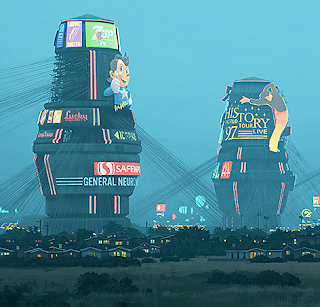3481.
Back in 2013-2014, which I documented for the record, I documented my stumbling upon the organic life's work of a man named Jerry Gretzinger, who was creating, as he went, an imaginary world, 8 x 11 sheet by 8 x 11 sheet.
 It's quite large now. over 50 feet long in one direction, and his world has toured the world, being shown in museums and art galleries. At first it was said to be called "Ukrania", but the name which has stuck is simply "Jerry's Map". Since it's been a while, here's the idea: Jerry began creating an imaginary city during lulls in a tedious job. The year: 1963. The original town, Wybourne (the original tile, pictured right) grew and grew from that beginning and then, as interests do, he moved on and shelved it. Eventually, a nephew discovered the stored map, asked him what it was, and he started growing it again. And never stopped.
It's quite large now. over 50 feet long in one direction, and his world has toured the world, being shown in museums and art galleries. At first it was said to be called "Ukrania", but the name which has stuck is simply "Jerry's Map". Since it's been a while, here's the idea: Jerry began creating an imaginary city during lulls in a tedious job. The year: 1963. The original town, Wybourne (the original tile, pictured right) grew and grew from that beginning and then, as interests do, he moved on and shelved it. Eventually, a nephew discovered the stored map, asked him what it was, and he started growing it again. And never stopped.
This is something I've done and many aspiring artists and map affectionados such as myself have copied it. To us, Jerry is a hero because he's made a true commentary on the many forms art takes ... process, evolution, accomplishment. He operates on a set of basic rules controlled and governed by his own internal logic and directed by a deck of around 100 command cards fashioned from recycled playing card decks. These cards prompt for everything from introducing new colors to generating new tiles to creating new collages on the tiles to archiving and refreshing the world. So, to my mind, like no other artist, Jerry's Map not only chronicles the change in art over time, but it chronicles the changes the artwork makes on the artist, who folds that back into the process. The changer is changing the changed, and the changed is changing the changer.
Today I stumbled on a sub-Reddit called "Mapping Like Jerry!". It's a collection of similarly-inspired and aspiring artists who, seeing what Jerry has done, are moved to create their own versions of imaginary worlds. Jerry himself takes part, joyous as the friends he's obviously made along the way.
The sub-Reddit is at https://www.reddit.com/r/JerryMapping/.
 It's quite large now. over 50 feet long in one direction, and his world has toured the world, being shown in museums and art galleries. At first it was said to be called "Ukrania", but the name which has stuck is simply "Jerry's Map". Since it's been a while, here's the idea: Jerry began creating an imaginary city during lulls in a tedious job. The year: 1963. The original town, Wybourne (the original tile, pictured right) grew and grew from that beginning and then, as interests do, he moved on and shelved it. Eventually, a nephew discovered the stored map, asked him what it was, and he started growing it again. And never stopped.
It's quite large now. over 50 feet long in one direction, and his world has toured the world, being shown in museums and art galleries. At first it was said to be called "Ukrania", but the name which has stuck is simply "Jerry's Map". Since it's been a while, here's the idea: Jerry began creating an imaginary city during lulls in a tedious job. The year: 1963. The original town, Wybourne (the original tile, pictured right) grew and grew from that beginning and then, as interests do, he moved on and shelved it. Eventually, a nephew discovered the stored map, asked him what it was, and he started growing it again. And never stopped.This is something I've done and many aspiring artists and map affectionados such as myself have copied it. To us, Jerry is a hero because he's made a true commentary on the many forms art takes ... process, evolution, accomplishment. He operates on a set of basic rules controlled and governed by his own internal logic and directed by a deck of around 100 command cards fashioned from recycled playing card decks. These cards prompt for everything from introducing new colors to generating new tiles to creating new collages on the tiles to archiving and refreshing the world. So, to my mind, like no other artist, Jerry's Map not only chronicles the change in art over time, but it chronicles the changes the artwork makes on the artist, who folds that back into the process. The changer is changing the changed, and the changed is changing the changer.
Today I stumbled on a sub-Reddit called "Mapping Like Jerry!". It's a collection of similarly-inspired and aspiring artists who, seeing what Jerry has done, are moved to create their own versions of imaginary worlds. Jerry himself takes part, joyous as the friends he's obviously made along the way.
The sub-Reddit is at https://www.reddit.com/r/JerryMapping/.































